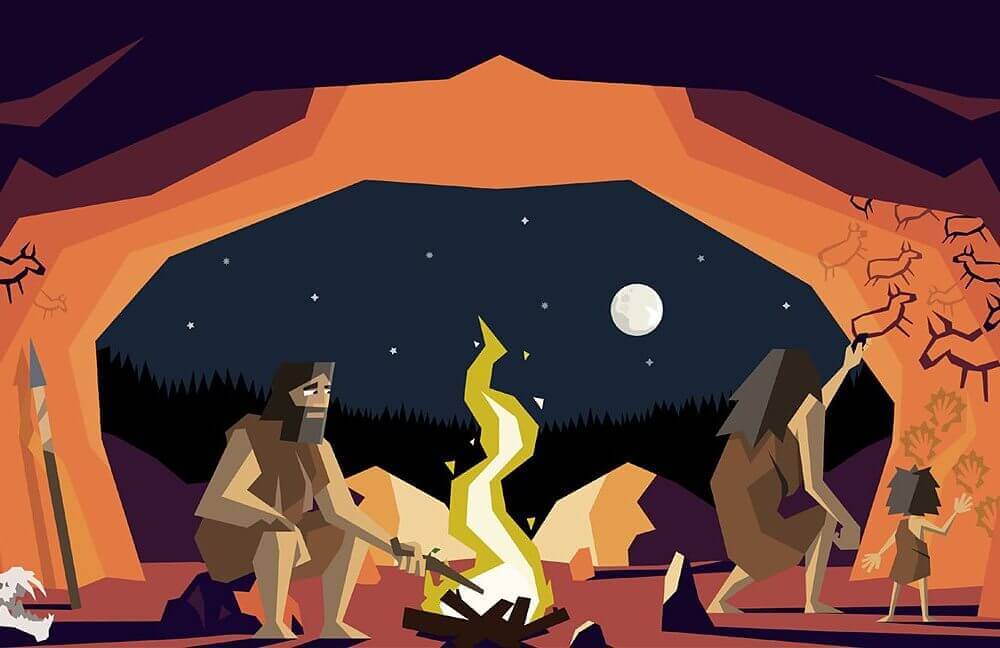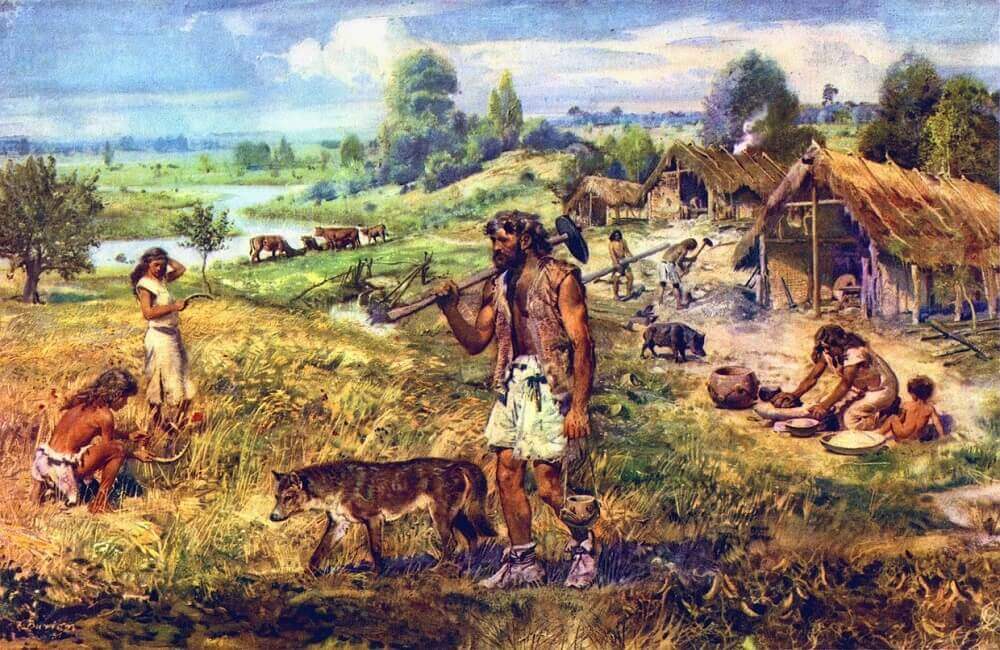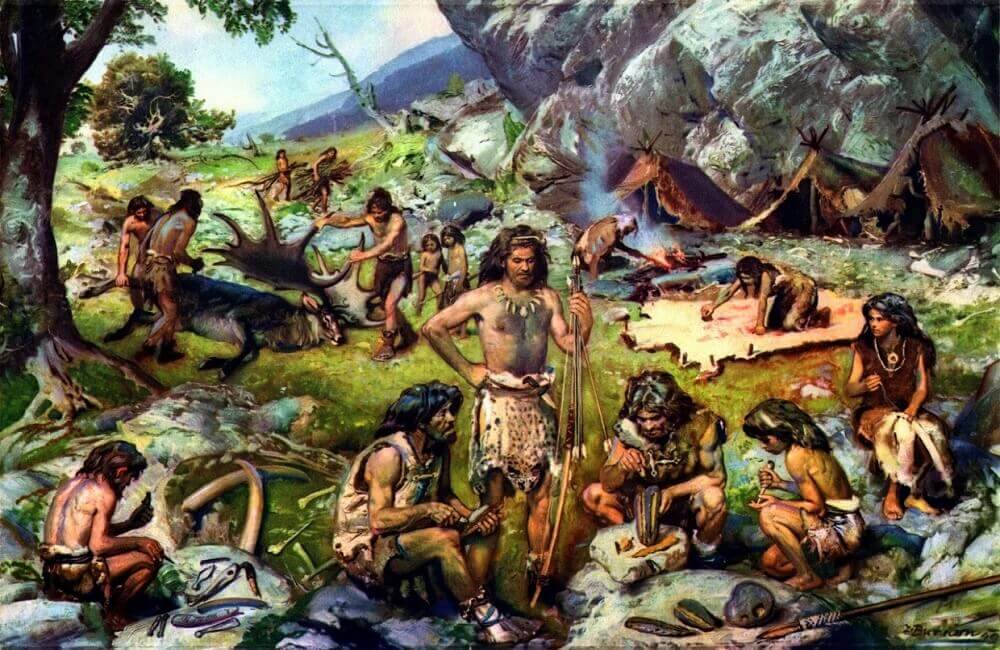
Often known as “The Old Stone Age”, the Paleolithic age is a time period that existed about 2.6 million years ago. During the Paleolithic Period, there were more than one human species that lived, such as Homo erectus, Neanderthal, Homo habilis, Homo heidelbergensis amongst others. However, most of the species died and now there is only one: Homo sapiens, which is us.
During the Paleolithic Period, human-like species used stone tools most often. Thus, the name Paleolithic age or stone age. Stone tools were used to meet the three basic needs of humans: food, shelter, and clothing. Huts were made of stone while caves were guarded using them, food was chopped and cooked using stone tools, and clothing often included a combination of leaves, stones, and earlier versions of ropes. In this article, we’ll learn about the Paleolithic age timeline, facts, tools, lifestyle, art, culture, language and more. So keep reading!
What is the Meaning of “Paleolithic”?
You must be wondering how and why the name “Paleolithic”? Well, just as for most other words, the term Paleolithic derived from the ancient (and dead) language: Greek. In Greek, the word “Paleo” means “old” while the world “Lithos” means Stone. During the Paleolithic Period, humans and human-like species were still evolving and not as intelligent or structurally similar to modern humans, thus “old.” Moreover, since the primary tool used in the Paleolithic Period was stone, “lithos” was added to the world, forming “Paleolithic”.
Paleolithic Period Timeline
The Paleolithic Period timeline can be briefly classified as Stone Age, Early Stone Age, Middle Stone Age, and Neanderthals; some of these time periods did indeed coexist. A brief of the sub-periods of the Paleolithic Period is given below.
Early Stone Age (Lower Paleolithic Period)
The Lower Paleolithic Period spanned from 3.4 million years ago to 3 hundred thousand years ago. Homo Erectus, Homo habilis, and Homo ergaster were the most dominating species during this time period. They also often ended up waging war against each other. The greatest achievement was the discovery of the ability to shape stones and their applications.
Stone Age
The Stone Age existed 2.5 million years to 20 thousand years ago. Archaeology and paleontology were the two great inventions that took place during the Paleolithic Period. Hunting, carving on caves, and cooking using stone tools were still in the developmental phase during this time period.
Middle Stone Age
The Middle Stone Age spanned from 2 hundred thousand years to 45 thousand years ago. This was the time when Homo sapiens, as in our own species, were seen for the first time (and were visibly smarter than the other Homo species). Moreover, Neanderthals also evolved during the Middle Stone Age. During this period, the use of stone was mastered by the Homo species, who used it almost everywhere (like we use electricity almost everywhere today).
Upper Stone Age (Upper Paleolithic Period)
The Upper Stone Age was a time period that lasted from 45 thousand years ago to 10 thousand years ago. During this period, most of the other Homo species apart from Homo sapiens disappeared or were in the process of extinction. The only human-like species remained Neanderthals, who existed till 30 thousand BP. In the Upper Stone Age, humans had made use of stone to such an extent that they now felt limited by their tool. Thus, this was the last time period in the stone age which then moved on to the Bronze Age.
Paleolithic Age Facts

The Paleolithic Period was a time period consisting of interesting events and marked important evolutions that led to the current lifestyle of humans. Here are some facts about the Paleozoic Era that will deeply intrigue you:
- The most common way of dying during the Paleozoic Period was by being the dinner of a predator.
- Human families, in general, had a minimum of 4 cubs.
- The primary tool used in almost anything, from cooking to hunting, was stone (generally along with wood).
- The first signs of humans using language were found to be in the Paleolithic Period.
- The concept of wearing something on the body (clothes) was extremely low in humans before the stone age and never done by any animal apart from humans. However, during the stone age, wearing clothes almost became a necessity for humans.
- Humans were not the only highly intelligent species during the Paleozoic Period. Apart from Homo sapiens (humans), Homo erectus, Neanderthal, Homo habilis, Homo heidelbergensis were amongst the various species that evolved from monkeys and had high intelligence level.
- People during the Paleolithic Period could actually do spray painting.
Art in Paleolithic Age
One of the most famous features of the Paleolithic Period is its art. Humans and human-like species famously drew (or sculpted) images of their lifestyle, hunting down animals, etc. on the walls of the caves they lived in and stone tablets that they made by chipping raw stone into a cuboidal structure.
Most of the known Paleolithic Arts were produced during the Aurignacian-Perigordian Period (14 thousand BC to 13.5 thousand BC). They include Lascaux Painting (the sculpture at Laussel) and Venuses (various male and female figurines). Another time period when a significant amount of Paleolithic Arts was produced is Solutreo-Magdalenian (14 thousand BC to 9.5 thousand BC). During this time period, various murals were made, which can today be found in various caves, such as Rouffignac Cave, the Cave of Niaux, and the Cave at Altamira.
The style of painting during the Paleolithic Period, called Franco-Cantabrian, includes various techniques, such as painting with fingers, sticks, and heaps of fur or moss. The painting was done by dotting or dabbing and sketching with colored materials and charcoal. Spray painting was also during the time, by blowing into hollow bones. Artworks were often arranged close to each other, either to manage space or to create an artistic effect depicting a happening and busy life.
Lifestyle During The Paleolithic Age

During the Paleolithic Period, survival was the key thing amongst humans and human-like animals. Unlike modern-day, during the Paleolithic Period, people weren’t as “civilized” and lived in jungles. They were exposed to almost all animals and insects and could be attacked any second. Therefore, their primary lifestyle included daily defense practices such as hunting which enabled them to protect themselves in those frequent occasions when their life was put at stake by predators.
The primary food during the Paleolithic Era was meat, fruit, and vegetables. People went for collecting coconuts and other fruits and vegetables from trees and grasslands, while they used stone weapons such as bamboo spears with the stone tip to hunt animals down. Thus, during the Paleolithic Period, people did not have any markets from where they could just purchase their food. After a day of hard work, they would be rewarded with the “fruit” of their sweat!
However, they didn’t just eat raw meat or vegetables. Just like we do today, people during the Paleolithic Period had already discovered fire so most of the tribes were accustomed to cooking their meat and vegetables before eating them. Nevertheless, they obviously did not have any spices, so they were still eating just meat and vegetables – straight from fire to their mouth!
Amongst larger tribes, every night there was what we call today a “campfire”. The tribe would gather around fire put up by burning large logs of wood (cut using stone axes). Around this fire, they would eat, sing, dance, and enjoy after a day of hard work. This time was their “leisure” time.
The primary shelter during most of the Paleolithic Period were caves, although some tribes did make and live in their huts. Caves are made naturally, so most families went around finding a suitable cave for their family (usually with at least 4 cubs) and making it their territory. They protected their caves by fencing it using large stones as a signal to other humans and animals that this place was “taken.” Some of those tribes who built their own huts used stones and grass (mostly hay) to build up their shelter. Huge pillars made of bamboo and other wood were secured to the ground using stone, and surrounding by all sides and on the top using hay, with one entrance held apart (also) by stones, to made simple but effective shelter.
But food and shelter are not enough. Citizens of the Paleolithic Period were also accustomed to wearing clothes. The primary material that made their clothes was an animal’s skin (usually a large cat such as a cheetah or a tiger) wrapped around the body, secured by sharp stones. They also had jewelry, which was basically a thread that was filled by shells and other fancy stones discovered during the time. Most archeologists suggest that humans wandered without any footwear, though we don’t know for sure.
Transport was also evolving – though very slowly – during the Paleolithic Period. While there were no tires, people used animals such as horses or donkeys for traveling. However, for most of the stone age, people wandered on their feet.
Fun Fact: The life expectancy during the Paleolithic Period was 30 years.
Tools Used During The Paleolithic Period
The toolkit of the Paleolithic Period was mostly made of stones. The toolkit of an average citizen of the Paleolithic Period includes the following items:
- Hammerstones, which were stones used to strike off other stones to sharpen them or burn fire (though the sparkles the strike produces)
- Sharp Stones (flints) which were also used as knives
- Bows made of bamboo and arrow made of wood body and stone tip
- Spear with a bamboo/wood body and long sharp stone tip
- Stone utensils (stones that were hollowed from the inside to hold other items)
- Nets made of thread and joints connected by stone, mostly to catch fish
- Axes, made of stones that were deliberately sharpened on one side
Clearly, the tools used in the stone age had something to do either with eating or with hunting. We can see how their most prominently made use of stone, bamboo, and wood.
Technological Advancement In Paleolithic Period
Stone tools are perhaps the first technological innovations that historians can use to reconstruct the worlds of Paleolithic peoples. Anthropologists suggest that citizens of the Paleolithic period spent most of their time hunting, foraging, and employed a system for dividing labor and resources amongst their community. The various innovations that Stone Age people have been able to do with stone such as making the first bows and arrows, spears, basic versions of knives (flints), etc. have made a lasting impact on the evolution of humans.
Language And Culture During The Paleolithic Period
Language is arguably the most important thing that the Paleolithic Period has given to humans. Scientists claim that the usage of language started taking off during the Paleolithic Period as they started traveling more often, living with other tribes, made use of art, amongst other social activities. Without the use of language, these acts would be extremely hard to accomplish.
However, there is much more than language in social life during the Paleolithic Period. Culture was (and is) one of the biggest parts of social beings. During the Paleolithic Period, ancient paintings and sculptures suggest that people celebrated various festivities that included beheading an animal, such as a lion (that shows the strength and dominion of the human), during the night in their “campfire”. Moreover, the evolution of art further proves the importance and presence of culture in life during the Paleozoic Era.
Alrighty, that’s about the end of the Paleolithic Period (pun intended). I hope you found this article intriguing, informative, and nerdy! From barely figuring out how to burn fire to making use of stones to such an extent that its limits were an obstacle, humans evolved extremely in terms of their curiosity, intelligence, and sociality during the Paleolithic Period, and without these advancements, we wouldn’t be here reading this information on this screen. The importance of the Paleolithic age in evolution, thus, marks a benchmark and makes all of us nerds interested in knowing more!
If you have any doubts or would like to share something new, be sure to make use of that comments section below! Nerdy Caterpillar makes sure that you get information of the highest and nerdiest quality. See you soon… Adios!
References:
https://www.britannica.com/event/Paleolithic-Perio
https://www.penfield.edu/webpages/jgiotto/onlinetextbook.cfm?subpage=1525824
http://historyrocket.com/age-of-history/stone-age/paleolithic/Paleolithic-Timeline.html
https://www.encyclopedia.com/reference/encyclopedias-almanacs-transcripts-and-maps/paleolithic-art
http://www.historyrocket.com/age-of-history/stone-age/paleolithic/Paleolithic-Lifestyle.html
https://www.khanacademy.org/humanities/world-history/world-history-beginnings/origin-humans-early-societies/a/paleolithic-culture-and-technology
http://www.visual-arts-cork.com/prehistoric/paleolithic-art-culture.htm
You May Also Like To Read:
Cenozoic Era – Definition, Facts, Timeline, Animals, Plants
Paleozoic Era – Definition, Facts, Timeline, Climate And Animals
Mesozoic Era – Definition, Facts, Timeline, Plants, Animals, And How It Ended
